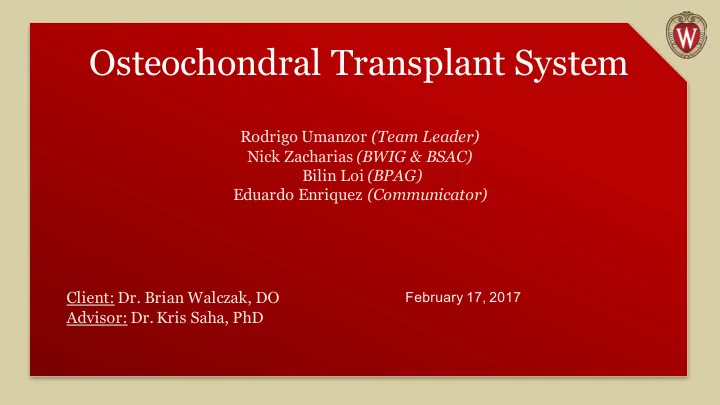

Osteochondral Transplant System Rodrigo Umanzor (Team Leader) Nick Zacharias (BWIG & BSAC) Bilin Loi (BPAG) Eduardo Enriquez (Communicator) Client: Dr. Brian Walczak, DO February ¡17, ¡2017 Advisor: Dr. Kris Saha, PhD
Overview ● Client Overview ● Problem Statement ● Background on Procedure ● Current Designs ● Design Ideas ● Design Matrix ● Future Work Image ¡Courtesy ¡of: ¡http://ptrefer.com/education/edu_inj/53/Articular_Cartilage_Injury__Osteochondral_defect
Client: Dr. Brian Walczak, DO ● Faculty, UW-Madison School of Medicine and Public Health ● Specialties: ▪ Orthopedic Surgery ▪ Pediatric Sports Medicine Walczak_Brian_DO.jpg ▪ Knee Arthroscopy
Problem Statement Osteochondral transplants are commonly used to ● correct defects in cartilage and bone tissue 20-25% chance of failure (Chahal, J, et al, 2013) ● Our Role: ● Create a new system that reduces the forces ▪ applied to cartilage layer during insertion Increase chondrocyte viability to decrease ▪ failure rate of procedure Figure 1: Graft recipient site (above) and inserted graft (below) 4 Images Courtesy of: S. Akhavan, A. Miniaci, M. T. Provencher, C. B. Dewing, A. G. McNickle, A. B. Yanke, and B. J. Cole, “Cartilage Repair and Replacement: From Osteochondral Autograft Transfer to Allograft,” in SURGICAL TREATMENT OF THE ARTHRITIC KNEE: ALTERNATIVES TO TKA , pp. 9–30.
Product Design Specifications (PDS) ● Achieve more than 70% viability → impaction forces < 165 N during implantation (Walczak, et al, 2016) ● Graft must exhibit proper integration postoperatively ● Tools used in procedure should be capable of operating on bone ● Range of 5mm-20mm diameter and at least 10 mm depth for damage repair ● Materials should be sterilizable and comply with FDA regulations
Proposed Design Procedure Current Clinical Procedure 5 Reference: “ALLOGRAFT CARTILAGE TRANSPLANT SURGICAL TECHNIQUE,” MTF Sports Medicine . [Online]. Available: https://www.mtf.org/documents/PI_-43_Rev_4.pdf. [Accessed: 16-Feb-2017].
Fluorescent Microscopy ● Stain ● Incubate ● Cryofreeze and Section thinly ● Image Figure 2: Fluorescent Microscope 7 Image Courtesy of http://www.spachoptics.com
Flow Cytometry ● Digest using collagenase ● Stain Cells ● Fix ● Run through flow cytometer ▪ obtain live/dead numbers Figure 4: Flow Cytometer 8 Image Courtesy of www.semrock.com
Confocal Microscopy ● Stain ● Incubate ● Fix and Section ● Image ▪ Multiple layers Figure 5: Confocal Microscope 9 Image Courtesy of http://www.immunohistochemistry.us
Design Matrix Criteria Fluorescent Microscopy Flow Cytometry Confocal Microscopy Accuracy (35) (3/5) 21 (4/5) 28 (5/5) 35 Cost (30) (5/5) 30 (1/5) 6 (4/5) 24 Ease of Use (20) (5/5) 20 (2/5) 8 (3/5) 12 Tissue Section Prep (10) (3/5) 6 (5/5) 10 (4/5) 8 Procedure Length (5) (3/5) 3 (2/5) 2 (5/5) 5 Total 80 54 84
Current Progress From Dec. 2016 Figure ¡1: ¡ Threaded ¡Bone ¡ plug Figure ¡2: ¡ Recipient ¡holes ¡ 400 ¡ um Figure ¡3: ¡Live ¡dead ¡staining. ¡ FITC (Live) TRITC (Dead)
Future Work ● Fabricate a guide to accurately extract a plug ● Thread the plug ● Test compatibility with threaded recipient hole Acknowledgments ● Dr. Saha ● Dr. Walczak
References 1. Chahal, J, et al. (2013). Outcomes of Osteochondral Allograft Transplantation in the Knee. Arthroscopy: The Journal of Arthroscopic & Related Surgery, 29(3), 575-588. doi:10.1016/j.arthro.2012.12.002 2. J. L. Cook et al., "Importance of Donor Chondrocyte Viability for Osteochondral Allografts," American Journal of Sports Medicine, vol. 44, no. 5, pp. 1260-1268, May 2016. 3. https://www.google.com/url?sa=i&rct=j&q=&esrc=s&source=images&cd=&ved=0ahUKEwjmr96UhtfPAhVhh1QKHbsdDFIQjRwIBw&url =http%3A%2F%2Fcartilage.org%2Fpatient%2Fabout-cartilage%2Fcartilage- repair%2Fallograft%2F&psig=AFQjCNHID7ILhAeE07d8eL5Kh4NSHNju3A&ust=1476422909199749 4. S. Akhavan, A. Miniaci, M. T. Provencher, C. B. Dewing, A. G. McNickle, A. B. Yanke, and B. J. Cole, “Cartilage Repair and Replacement: From Osteochondral Autograft Transfer to Allograft,” in SURGICAL TREATMENT OF THE ARTHRITIC KNEE: ALTERNATIVES TO TKA , pp. 9–30. 5. S. L. Sherman, J. Garrity, K. Bauer, J. Cook, J. Stannard, and W. Bugbee, "Fresh Osteochondral Allograft Transplantation for the Knee: Current Concepts (vol 22, pg 121, 2014)," Journal of the American Academy of Orthopaedic Surgeons, vol. 22, no. 3, pp. 199-199, Mar 2014. 6. “ALLOGRAFT CARTILAGE TRANSPLANT SURGICAL TECHNIQUE,” MTF Sports Medicine . [Online]. Available: https://www.mtf.org/documents/PI_-43_Rev_4.pdf. [Accessed: 16-Feb-2017]. 7. “OLYMPUS BX51 FLUORESCENCE MICROSCOPE,” Spach Optics Inc. , 2017. [Online]. Available: http://www.spachoptics.com/BX51-FL- p/olympus-bx51-fluorescence.htm. [Accessed: 16-Feb-2017]. 8. “Filters for Flow Cytometry,” IDEX Health & Science LLC. , [Online]. Available: https://www.semrock.com/flow-cytometry.aspx. [Accessed: 17-Feb-2017]. 9. “Immunohistochemical Microscopy,” Sino Biological Inc., 2013. [Online]. Available: http://www.immunohistochemistry.us/what-is- immunohistochemistry/immunohistochemical-microscopy.html. [Accessed: 17-Feb-2017].
Recommend
More recommend